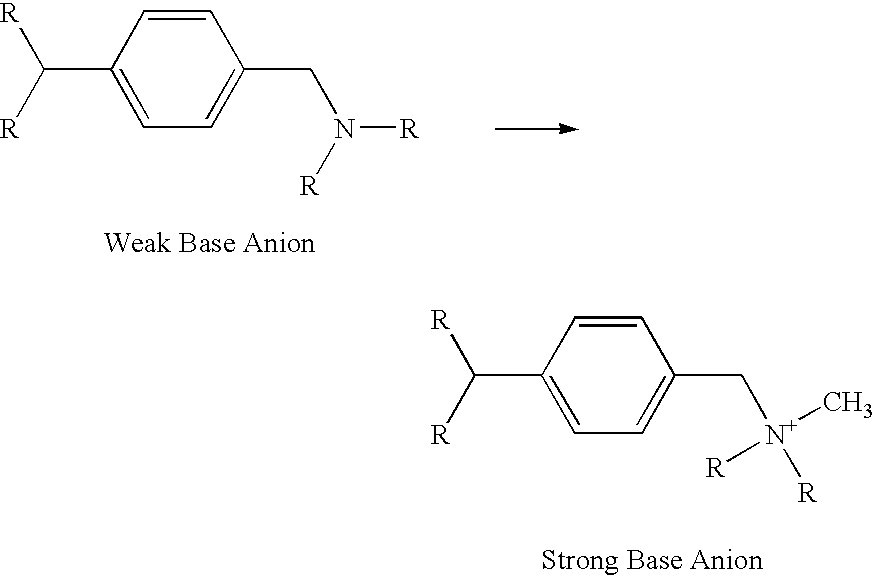Method for removal of arsenic from water
a technology of arsenic and water, applied in the direction of water/sewage treatment by ion exchange, other chemical processes, separation processes, etc., can solve problems such as extreme toxicity
- Summary
- Abstract
- Description
- Claims
- Application Information
AI Technical Summary
Benefits of technology
Problems solved by technology
Method used
Image
Examples
example 1
Preparation of a Cation Exchange Resin Loaded with Zirconium
[0051]The preparation of a cation exchange styrene / DVB resin loaded with zirconium may be found in the U.S. Patent No. 2003 / 0139629 A1.
example 2
Chloromethylation Process for Gel Styrene-DVB Copolymers
[0052]This is a description of the use of a conventional stirred (agitated) quench procedure with no recovery and recycle of the reaction liquor. A chloromethylated intermediate is prepared by adding 244 g of CSA over a 4 hour period to an agitated reaction vessel containing 106 g of p(St-DVB) containing 4.3% DVB, 136 g of an aqueous formaldehyde solution (55% formaldehyde, 35% MeOH), 40 g of aqueous HCl (35%), 32 g of MeOH and a sufficient amount (typically about 15 g) aqueous ferric chloride (40%) solution to provide a molar ratio of ferric chloride to p(St-DVB) of 0.04 / 1. The temperature of the reaction mixture during the CSA addition is maintained at 40° C. and below. After completion of the CSA addition, the reaction mixture is held at 38-40° C. for a period of 2.5 hours with agitation. The reaction mixture is cooled to 25-30° C. and a quench solution (330 g of water) is added to the chloromethylated intermediate while agi...
example 3
Amination of the Halomethylated Gellular Styrenic-DVB Copolymer
[0053]The term “Amine” is used to describe the specific amine used in the example, which is a 40% aqueous solution of trimethylamine.
[0054]The washed chloromethylated intermediate from example 2. is slurried with 200-400 g of water and neutralized with 50% aqueous NaOH to a pH of 8-10; this is followed by the addition of 176 g of the Amine with cooling to maintain a temperature of 20-25° C. The temperature of the reaction mixture is then raised to 50° C. over 3 hours and held at 50° C. for an additional 2 hours. At this point 8 g of a 50% aqueous NaOH solution is added to the reaction mixture and excess trimethylamine is recovered by distillation. The resultant anion exchange resin beads (SBA) are drained free of residual liquid, and washed with hot water and dilute aqueous HCl to remove residual iron and Amine contaminants. The resulting SBA typically has an anion exchange capacity of 1.3 meq / ml (4.1 meq / g) with 99% PB....
PUM
| Property | Measurement | Unit |
|---|---|---|
| temperature | aaaaa | aaaaa |
| temperature | aaaaa | aaaaa |
| temperature | aaaaa | aaaaa |
Abstract
Description
Claims
Application Information
 Login to View More
Login to View More - R&D
- Intellectual Property
- Life Sciences
- Materials
- Tech Scout
- Unparalleled Data Quality
- Higher Quality Content
- 60% Fewer Hallucinations
Browse by: Latest US Patents, China's latest patents, Technical Efficacy Thesaurus, Application Domain, Technology Topic, Popular Technical Reports.
© 2025 PatSnap. All rights reserved.Legal|Privacy policy|Modern Slavery Act Transparency Statement|Sitemap|About US| Contact US: help@patsnap.com

